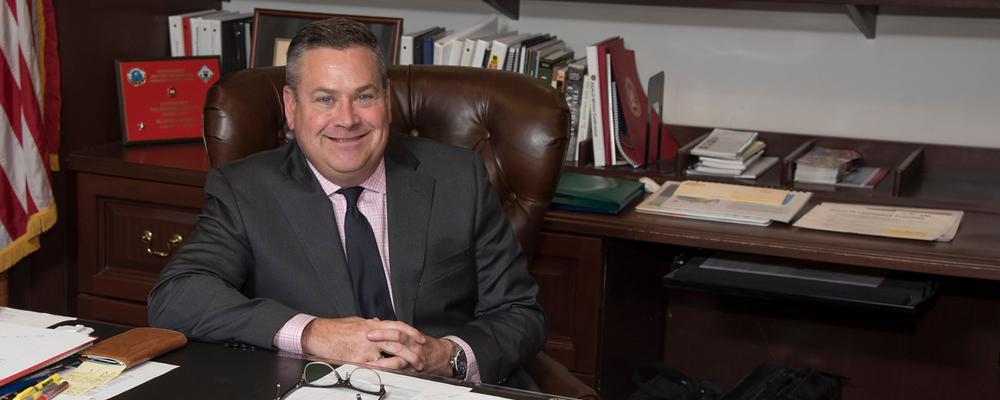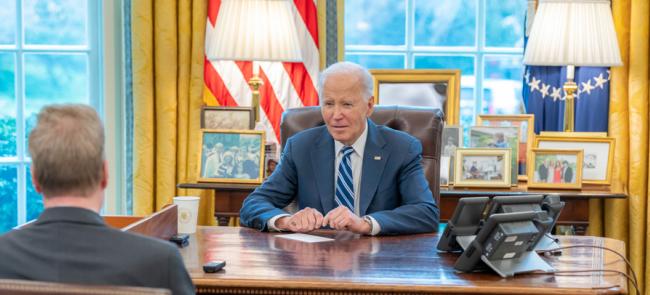
Count On Us
Our country followed a year no one imagined with a 2021 that was hardly much better. But, once again, things would’ve been much worse for many Americans without the National Guard.
Over the last two years, never have so many Guard soldiers and airmen undertaken so many missions to help their communities in a time of need.
I thought the same thing last year, and then in the last few months we’ve seen the Guard help fill shortages of school bus drivers in Massachusetts and substitute teachers in New Mexico.
One commentator has called the Guard “the governors’ Swiss Army knife.” It’s quite a compliment, but we’re also the primary combat reserve for the Army and Air Force, so we do have to balance state missions with our need to train for wartime missions.
Count members of Congress among those who have noted the increasing value of the Guard to the nation. They monitor the news from back home. And lawmakers at this time last year couldn’t walk from their offices to the U.S. Capitol without seeing Guard soldiers and airmen.
The capitol security mission went on too long, but it certainly underscored the Guard’s responsiveness and versatility.
All of this has made members of Congress a little more receptive when we tell them that many Guardsmen respond to domestic emergencies without medical coverage. We also repeatedly remind lawmakers that Guardsmen operate the oldest equipment in the U.S. military and receive benefits that pale in comparison to their active component brothers and sisters.
NGAUS made some progress on the latter in the fiscal 2022 Defense Authorization Act. A provision will enable Guard soldiers and airmen who receive incentive pay to soon be compensated at the same rate as those in the active component.
Incentive pay parity was a NGAUS legislative priority last year; the association legislative staff even helped draft the language. Guardsmen have long been expected to meet the same standards as their active-component counterparts but receive only fractional amounts of incentive pay.
The change will put thousands of additional dollars in the pockets of flight crews and many other Guardsmen over their careers, but it won’t begin right away. A late addition to the provision gives the services until Sept. 30 to develop implementation language.
We also now have legislation under consideration in the House to provide medical coverage to every part-time member of the Guard and Reserves.
Introduced in May by Rep. Andy Kim, D-N.J., and Rep. Trent Kelly, R-Miss., the Healthcare for Our Troops Act (H.R. 3512), would offer no-fee coverage through TRICARE, the military’s health insurance program.
While the bill has picked up several co-sponsors, it will be an uphill fight. Many in the House have told us that they’re concerned with the initial costs.
Our response is always the same — it will increase recruiting and retention as well as reduce the amount of post-mobilization medical procedures and lost training days for the one in five who have no private coverage and lack access to preventive health care. Cost avoidance here would exceed the expenditure.
This has to be part of our messaging all the way down to the grassroots level.
Many people we talk to outside of Congress — reporters, state and local officials, even some in the active component — are surprised when we tell them that our country doesn’t provide Guard soldiers and airmen with medical coverage.
It’s long past time to change that.
The change will put thousands of additional dollars in the pockets of flight crews and many other Guardmsen.
ANOTHER ONE of our major accomplishments in 2021 was an in-person conference — our first since before the pandemic.
As most members know, the annual NGAUS conference is where we conduct the business of our association. This includes board elections, changes to our governing bylaws and setting our legislative agenda for the next year. There is also a one-of-a-kind trade show.
But to me, the event is bigger than that. The opportunity to share information and network fact-to-face is simply invaluable — both to our association and the National Guard in total. It’s the one time each year when “the 54” becomes one.
That’s why we were so determined last year to offer the kind of event our attendees have come to expect and deserve. We did that in August in Las Vegas when many other associations took another year off from in-person events. And the membership responded. I’m proud of that.
The conference is also a big reason for some of our staff changes. Retired Lt. Col. Robert “Jake” Jakubek, our longtime chief of staff and conference coordinator has become NGAUS vice president-business development & general conference. We want to grow the conference and the exhibition. That will be his focus.
We also elevated the head of our legislative department, retired Col. Mike Hadley, to be NGAUS vice president-government affairs. The title is in keeping with many of his peers in other associations.
Retired Air Guard Col. Paul Drake of Mississippi is the new chief of staff. He has a joint background. In fact, in his last assignment, he taught at the Army War College in Carlisle, Pennsylvania. Among the courses he taught was How Congress Runs. My longtime colleague is a great fit.
And we are excited about our new digital life membership program. NGAUS has long offered life memberships. You pay once or via installments and never have to concern yourself with dues again. But many company-grade officers have told us that $1,000 was beyond their means.
Maj. Gen. Richard Neely, the adjutant general of Illinois, suggested the concept of a digital membership. Many young adults prefer to consume information online. If we provided only the digital version of the magazine, we could pass along the lifetime savings of one less magazine to print and mail.
The NGAUS membership committee led by Maj. Gen. Randall Simmons of Georgia did the research and found that some other associations were marketing similar membership programs. The committee came up with a price of $500 and the board of directors approved a four-year trial.
Early returns are great. By the end of January, we’ve sold more than 1,000 digital life memberships.
We seek further progress toward parity with the active component on equipment, resources and benefits.
OUR LEGISLATIVE PRIORITIES this year build on some of our successes in 2021. We seek further progress toward parity with the active component on equipment, resources and benefits. The same jobs and risks warrant the same tools and benefits.
One example is credit toward the Post-9/11 GI Bill. Active-component personnel receive it every day they serve. Reservists receive credit when they go to schools. Guardsmen only get it on Title 32 when they are responding to a presidential emergency.
A legislative remedy is in the works. The House passed the National Guard and Reserve GI Bill Parity Act (H.R. 1836) last month. Now, we need Senate action.
We will also be pushing the Healthcare for Our Troops Act (H.R. 3512). It will be the tougher sell of the two, but we do have some help from the Pentagon on this. It’s a top priority for Gen. Daniel R. Hokanson, the chief of the National Guard Bureau.
Unfortunately, progress on much of this will have to wait unit Congress agrees on a budget for fiscal 2022. The government is currently operating on a stopgap budget, which means spending is at 2021 levels with no new projects.
The good news is, the parties do seem to be coming together. Word from Capitol Hill is the final defense appropriations will include funds for new aircraft for both the Army and Air Guard, including UH-60 Black Hawk helicopters and C-130J cargo planes. It looks like we could see that sometime next month.
We will continue to weigh in on discussions in Washington and elsewhere on precisely who is in charge of the Guard.
There is a bottom line here: The National Guard is a predominantly part-time, state military force under the command and control of the governor until mobilized for federal duty by the president.
Of course, the federal government provides the vast majority of the resources. In addition, the services set the training standards. But our soldiers and airmen can serve only one commander in chief at a time, and until called to federal active duty, that person is the governor.
All of this is codified in law. The Guard has both a state and federal mission, so from time to time, there will be conflicts. But the system works for the good of the nation. The Guard’s nearly two-year-old COVID response would not be possible by a fully federal force.
I will end by thanking you for all you did in 2021. You made another tough year for many Americans a little easier. And people across the nation, including here on Capitol Hill, noticed.
Have a safe and prosperous 2022. And rest assured, you can count on NGAUS to give you a voice in Washington.
Retired Brig. Gen. J. Roy Robinson is entering his sixth year as NGAUS president. He can be reached via ngaus@ngaus.org.
2022 NGAUS LEGISLATIVE PRIORITIES
(For the deliberation of the fiscal 2023 defense authorization and appropriations acts)
The Same Organization
● Future multi-domain battlefield interoperability, includes:
■ Deployable and interoperable force structure that is validated and doctrinally consistent
■ Space National Guard as the primary combat reserve component within the Space Force
■ Continued National Guard integration in the Total Force cyber mission and training
The Same Equipment
● Deployable, Interoperable & Sustainable Equipment
● Concurrent and proportional fielding of equipment to the National Guard, includes:
■ UH-60M Black Hawk, F-35A Lightning II, KC-46A Pegasus, C-130J Super Hercules & Future Vertical Lift procurement
● National Guard equipment modernization and recapitalization, including:
■ AH-64E Apache battalions, M1 Abrams tank & M2 Bradley, Humvee
■ A-10 Thunderbolt II, F-15 Eagle & F-16 Fighting Falcon
The Same Resources & Benefits
● Zero-cost TRICARE to ensure reserve-component medical readiness
● Post-9/11 GI Bill parity
● Robust National Guard & Reserve Equipment Account funding
● Tax incentives for Guardsmen and employers
● Ready access to mental health care and suicide prevention
● Increased National Guard military construction funding



